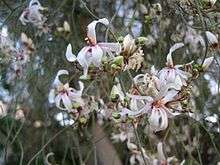Moringa peregrina
Moringa peregrina is a species of flowering plant in the family Moringaceae that is native to Arabian Peninsula Horn of Africa and Southern Sinai, Egypt[1] and can be found throughout Arabia, Egypt and as far north as Syria. Moringa peregrina grows on rocky wadis and on cliffs in drier areas.[2]
| Moringa peregrina | |
|---|---|
 | |
| Scientific classification | |
| Kingdom: | Plantae |
| Clade: | Tracheophytes |
| Clade: | Angiosperms |
| Clade: | Eudicots |
| Clade: | Rosids |
| Order: | Brassicales |
| Family: | Moringaceae |
| Genus: | Moringa |
| Species: | M. peregrina |
| Binomial name | |
| Moringa peregrina | |
| Synonyms | |
|
shooeh شوع , Ban بان | |
Description
Moringa peregrina is a deciduous tree, 6-10m tall, with large leaves and thin pendulous branches. Its flowers are five petaled, white or streaked red or pink. Its fruits are distinctive and can be seen hanging from its branches throughout the year. The fruits are narrowly cylindrical, up to 30 cm long and marked with deep longitudinal grooves. When ripe they split into three valves shedding the large whitish seed.[3]
Uses
Moringa peregrina were used for home construction and fires, and its leaves consumed as food and livestock feed.[4] In eastern Oman, young Moringa peregrina saplings would be dug up and its roots slowly roasted in a fire for food. In Oman, oil extracted from pods was used in traditional medicine and in perfumery.[5]
References
- Dadamouny, M.A., Unterseher, M., König, P., & Schnittler, M. (2016) (2016). "Population performance of Moringa peregrina (Forssk.) Fiori (Moringaceae) at Sinai Peninsula, Egypt in the last decades: Consequences for its conservation". Journal for Nature Conservation. 34: 65–74. doi:10.1016/j.jnc.2016.08.005.
- G. Miller, Anthony; Morris, Miranda (1988). Plants of Dhofar. Oman. p. 210. ISBN 071570808-2.
- G. Miller, Anthony; Morris, Miranda (1988). Plants of Dhofar. Oman. p. 210. ISBN 071570808-2.
- G. Miller, Anthony; Morris, Miranda (1988). Plants of Dhofar. Oman. p. 210. ISBN 071570808-2.
- G. Miller, Anthony; Morris, Miranda (1988). Plants of Dhofar. Oman. p. 210,326. ISBN 071570808-2.